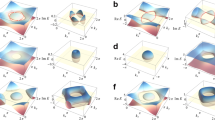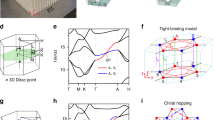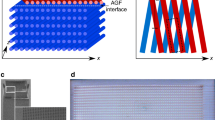Abstract
Gauge fields play a major role in understanding quantum effects. For example, gauge flux insertion into single unit cells is crucial towards detecting quantum phases and controlling quantum dynamics and classical waves. However, the potential of gauge fields in topological materials studies has not been fully exploited. Here, we experimentally demonstrate artificial gauge flux insertion into a single plaquette of a sonic crystal with a gauge phase ranging from 0 to 2π. We insert the gauge flux through a three-step process of dimensional extension, engineering a screw dislocation and dimensional reduction. Additionally, the single-plaquette gauge flux leads to cyclic spectral flows across multiple bandgaps that manifest as topological boundary states on the plaquette and emerge only when the flux-carrying plaquette encloses the Wannier centres. We termed this phenomenon as the topological Wannier cycle. This work paves the way towards sub-unit-cell gauge flux, enabling future studies on synthetic gauge fields and topological materials.
This is a preview of subscription content, access via your institution
Access options
Access Nature and 54 other Nature Portfolio journals
Get Nature+, our best-value online-access subscription
$29.99 / 30 days
cancel any time
Subscribe to this journal
Receive 12 print issues and online access
$259.00 per year
only $21.58 per issue
Buy this article
- Purchase on Springer Link
- Instant access to full article PDF
Prices may be subject to local taxes which are calculated during checkout





Similar content being viewed by others
Data availability
All relevant data are presented in detail in the manuscript and the Supplementary Information. Additional information is available from the corresponding authors through reasonable request.
Code availability
We use the commercial software COMSOL Multiphysics to perform the acoustic wave simulations and eigenstate calculations based on finite-element methods. Reasonable requests to have the computation details can be addressed to the corresponding authors.
Change history
04 March 2024
A Correction to this paper has been published: https://doi.org/10.1038/s41563-024-01849-5
References
Aharonov, Y. & Bohm, D. Significance of electromagnetic potentials in the quantum theory. Phys. Rev. 115, 485–491 (1959).
Laughlin, R. B. Quantized Hall conductivity in two dimensions. Phys. Rev. B 23, 5632(R)–5633(R) (1981).
Halperin, B. I. Quantized Hall conductance, current-carrying edge states, and the existence of extended states in a two-dimensional disordered potential. Phys. Rev. B 25, 2185–2190 (1982).
Wen, X. G. Quantum Field Theory of Many-Body Systems (Oxford Univ. Press, 2004).
Tonomura, A. et al. Observation of Aharonov-Bohm effect by electron holography. Phys. Rev. Lett. 48, 1443–1446 (1982).
Albrecht, C. et al. Evidence of Hofstadter’s fractal energy spectrum in the quantized Hall conductance. Phys. Rev. Lett. 86, 147–150 (2001).
Geim, A. K., Bending, S. J. & Grigorieva, I. V. Asymmetric scattering and diffraction of two-dimensional electrons at quantized tubes of magnetic flux. Phys. Rev. Lett. 69, 2252–2255 (1992).
Goldman, N., Juzeliūnas, G., Öhberg, P. & Spielman, I. B. Light-induced gauge fields for ultracold atoms. Rep. Prog. Phys. 77, 126401 (2014).
Roushan, P. et al. Chiral ground-state currents of interacting photons in a synthetic magnetic field. Nat. Phys. 13, 146–151 (2017).
Aidelsburger, M., Nascimbene, S. & Goldman, N. Artificial gauge fields in materials and engineered systems. C. R. Physique 19, 394–432 (2018).
Lienhard, V. et al. Realization of a density-dependent Peierls phase in a synthetic, spin-orbit coupled Rydberg system. Phys. Rev. X 10, 021031 (2020).
Fang, K., Yu, Z. & Fan, S. Realizing effective magnetic field for photons by controlling the phase of dynamic modulation. Nat. Photon. 6, 782–787 (2012).
Rechtsman, M. C. et al. Strain-induced pseudomagnetic field and photonic Landau levels in dielectric structures. Nat. Photon. 7, 153–158 (2013).
Mittal, S., Ganeshan, S., Fan, J., Vaezi, A. & Hafezi, M. Measurement of topological invariants in a 2D photonic system. Nat. Photon. 10, 180–183 (2016).
Jia, H. et al. Observation of chiral zero mode in inhomogeneous three-dimensional Weyl metamaterials. Science 363, 148–151 (2019).
Lumer, Y. et al. Light guiding by artificial gauge fields. Nat. Photon. 13, 339–345 (2019).
Xiao, M., Chen, W.-J., He, W.-Y. & Chan, C. T. Artificial gauge flux and Weyl points in acoustic systems. Nat. Phys. 11, 920–924 (2015).
Fang, K. et al. Generalized non-reciprocity in an optomechanical circuit via synthetic magnetism and reservoir engineering. Nat. Phys. 13, 465–471 (2017).
Wen, X. et al. Acoustic Landau quantization and quantum-Hall-like edge states. Nat. Phys. 15, 352–356 (2019).
Peri, V., Serra-Garcia, M., Ilan, R. & Huber, S. D. Axial-field-induced chiral channels in an acoustic Weyl system. Nat. Phys. 15, 357–361 (2019).
Qi, X.-L., Hughes, T. L. & Zhang, S.-C. Topological field theory of time-reversal invariant insulators. Phys. Rev. B 78, 195424 (2008).
Ma, G., Xiao, M. & Chan, C. T. Topological phases in acoustic and mechanical systems. Nat. Rev. Phys. 1, 281–294 (2019).
Ozawa, T. et al. Topological photonics. Rev. Mod. Phys. 91, 015006 (2019).
van Miert, G. & Ortix, C. Higher-order topological insulators protected by inversion and rotoinversion symmetries. Phys. Rev. B 98, 081110(R) (2018).
Benalcazar, W. A., Li, T. & Hughes, T. L. Quantization of fractional corner charge in Cn-symmetric higher-order topological crystalline insulators. Phys. Rev. B 99, 245151 (2019).
Gao, J. et al. Unconventional materials: the mismatch between electronic charge centers and atomic positions. Preprint at https://arXiv.org/abs/2106.08035 (2022).
Xu, Y. et al. Filling-enforced obstructed atomic insulators. Preprint at https://arXiv.org/abs/2106.10276 (2021).
Liu, F. & Wakabayashi, K. Novel topological phase with a zero Berry curvature. Phys. Rev. Lett. 118, 076803 (2017).
Xie, B.-Y. et al. Second-order photonic topological insulator with corner states. Phys. Rev. B 98, 205147 (2018).
Xie, B.-Y. et al. Higher-order band topology. Nat. Rev. Phys. 3, 520–532 (2021).
Hughes, T. L., Prodan, E. & Bernevig, B. A. Inversion-symmetric topological insulators. Phys. Rev. B 83, 245132 (2011).
Turner, A. M., Zhang, Y. & Vishwanath, A. Entanglement and inversion symmetry in topological insulators. Phys. Rev. B 82, 241102(R) (2010).
Song, Z.-D., Elcoro, L. & Bernevig, B. A. Twisted bulk-boundary correspondence of fragile topology. Science 367, 794–797 (2020).
Peri, V. et al. Experimental characterization of fragile topology in an acoustic metamaterial. Science 367, 797–800 (2020).
van Miert, G. & Ortix, C. On the topological immunity of corner states in two-dimensional crystalline insulators. npj Quantum Mater. 5, 63 (2020).
Peterson, C. W. et al. A fractional corner anomaly reveals higher-order topology. Science 368, 1114–1118 (2020).
Ran, Y., Zhang, Y. & Vishwanath, A. One-dimensional topologically protected modes in topological insulators with lattice dislocations. Nat. Phys. 5, 298–303 (2009).
Teo, J. C. Y. & Kane, C. L. Topological defects and gapless modes in insulators and superconductors. Phys. Rev. B 82, 115120 (2010).
Juričić, V., Mesaros, A., Slager, R.-J. & Zaanen, J. Universal probes of two-dimensional topological insulators: dislocation and π-flux. Phys. Rev. Lett. 108, 106403 (2012).
de Juan, F., Rüegg, A. & Lee, D.-H. Bulk-defect correspondence in particle-hole symmetric insulators and semimetals. Phys. Rev. B 89, 161117(R) (2014).
Slager, R.-J., Mesaros, A., Juričić, V. & Zaanen, J. Interplay between electronic topology and crystal symmetry: dislocation-line modes in topological band insulators. Phys. Rev. B 90, 241403(R) (2014).
van Miert, G. & Ortix, C. Dislocation charges reveal two-dimensional topological crystalline invariants. Phys. Rev. B 97, 201111(R) (2018).
Queiroz, R., Fulga, I. C., Avraham, N., Beidenkopf, H. & Cano, J. Partial lattice defects in higher-order topological insulators. Phys. Rev. Lett. 123, 266802 (2019).
Slager, R.-J. The translational side of topological band insulators. J. Phys. Chem. Solids 128, 24–38 (2019).
Roy, B. & Juričić, V. Dislocation as a bulk probe of higher-order topological insulators. Phys. Rev. Res. 3, 033107 (2021).
Paulose, J., Chen, B. G. & Vitelli, V. Topological modes bound to dislocations in mechanical metamaterials. Nat. Phys. 11, 153–156 (2015).
Li, F.-F. et al. Topological light-trapping on a dislocation. Nat. Commun. 9, 2462 (2018).
Nayak, A. K. et al. Resolving the topological classification of bismuth with topological defects. Sci. Adv. 5, eaax6996 (2019).
Mukherjee, S. et al. Experimental observation of Aharonov-Bohm cages in photonic lattices. Phys. Rev. Lett. 121, 075502 (2018).
Lustig, E. & Segev, M. Topological photonics in synthetic dimensions. Adv. Opt. Photon. 13, 426–461 (2021).
Acknowledgements
Z.-K.L., B.J., Y.L., S.-Q.W. and J.-H.J. are supported by the National Natural Science Foundation of China (grant nos. 12125504 and 12074281), the Jiangsu Province Distinguished Professor Funding and the Key Lab of Advanced Optical Manufacturing Technologies of Jiangsu Province, Soochow University. J.-H.J. thanks Z.-D. Song for many helpful discussions. He also thanks Z. H. Hang for sharing his laboratory for part of the measurements, and the Huazhong University of Science and Technology, where a large part of the manuscript was finalized, for their hospitality. Y.W. and F.L. are supported by the Guangzhou Basic and Applied Research Foundation (no. 202102020349), the Natural Science Foundation of Guangdong Province (grant no. 2020A1515010549) and China Postdoctoral Science Foundation (grant no. 2020M672615).
Author information
Authors and Affiliations
Contributions
J.-H.J. initiated the project and guided the research. J.-H.J. and Z.-K.L. established the theory. Y.W., Z.-K.L., B.J. and Y.L. performed the numerical calculations and simulations. Y.W., Z.-K.L., S.-Q.W., J.-H.J. and F.L. designed and performed the experiments. All the authors contributed to the discussions of the results and the manuscript preparation. J.-H.J., Z.-K.L. and Y.W. wrote the manuscript and the Supplementary Information.
Corresponding authors
Ethics declarations
Competing interests
The authors declare no competing interests.
Peer review
Peer review information
Nature Materials thanks Marc Serra-Garcia and the other, anonymous, reviewer(s) for their contribution to the peer review of this work.
Additional information
Publisher’s note Springer Nature remains neutral with regard to jurisdictional claims in published maps and institutional affiliations.
Supplementary information
Supplementary Information
Supplementary Figs. 1–22, Tables 1 and 2 and Discussion.
Rights and permissions
Springer Nature or its licensor (e.g. a society or other partner) holds exclusive rights to this article under a publishing agreement with the author(s) or other rightsholder(s); author self-archiving of the accepted manuscript version of this article is solely governed by the terms of such publishing agreement and applicable law.
About this article
Cite this article
Lin, ZK., Wu, Y., Jiang, B. et al. Topological Wannier cycles induced by sub-unit-cell artificial gauge flux in a sonic crystal. Nat. Mater. 21, 430–437 (2022). https://doi.org/10.1038/s41563-022-01200-w
Received:
Accepted:
Published:
Issue Date:
DOI: https://doi.org/10.1038/s41563-022-01200-w
This article is cited by
-
Topological non-reciprocal robust waveguide transport
Science China Physics, Mechanics & Astronomy (2024)
-
Topological phenomena at defects in acoustic, photonic and solid-state lattices
Nature Reviews Physics (2023)
-
Topological solitonic macromolecules
Nature Communications (2023)
-
Topological zero-dimensional defect and flux states in three-dimensional insulators
Nature Communications (2022)
-
Topological properties that can be heard
Nature Materials (2022)



